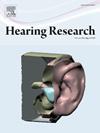双模人工耳蜗使用者的皮质颞失配补偿:选择性注意解码和瞳孔测量研究
IF 2.5
2区 医学
Q1 AUDIOLOGY & SPEECH-LANGUAGE PATHOLOGY
引用次数: 0
摘要
双模人工耳蜗(CI)使用者将一只耳朵的CI的电刺激与另一只耳朵的正常听力或助听器的声刺激结合起来。虽然这种双峰刺激通常会改善语音感知,但改善的程度差异很大,有时会导致干扰效应。这种变异性与电信号和声信号的整合有关,而电信号和声信号的整合可能受到几个因素的影响,包括双方之间的时间不匹配。在之前的工作中,我们利用皮质听觉诱发电位(CAEPs)来估计CI刺激(CIS)侧和AS刺激(AS)侧在时间上的不匹配,这是基于单独使用CIS和单独使用AS时N1潜伏期的差异。在此基础上,本研究通过caep的N1潜伏期估计了皮质水平上个体的时间不匹配,并研究了补偿这种不匹配对语音感知的影响。在三种双峰聆听条件下,对双峰CI使用者进行了言语感知的行为和客观测量:临床环境、电刺激和声刺激之间的补偿时间失配环境和电刺激与声刺激之间50 ms的大时间失配环境。行为测试包括言语理解测试。客观测量包括瞳孔测量、基于皮质听觉诱发电位(CAEPs)的脑电图、基于选择性注意解码(包括顶叶α功率分析)的脑电图。听力条件对行为言语理解的影响不显著,即使在50 ms的大时间失配条件下也是如此。同样,瞳孔测量也没有显示出不同听力条件下的显著差异,尽管它被发现与行为语言理解有关。补偿时间失配条件下,caep的N1P2振幅最大。与50 ms时间失配相比,caep锁相值、选择性注意解码相关的时间响应函数和顶叶α功率均有显著提高。然而,与标准的临床环境条件相比,这些指标并没有表现出显著的效果。这些发现强调,神经指标在检测耳间失配效应方面比行为指标更敏感。与临床相比,CAEPs N1P2振幅显著增强。其他神经指标显示补偿听力条件的改善有限,表明仅在颞域补偿不足。本文章由计算机程序翻译,如有差异,请以英文原文为准。
Cortical temporal mismatch compensation in bimodal cochlear implant users: Selective attention decoding and pupillometry study
Bimodal cochlear implant (CI) users combine electrical stimulation from a CI in one ear with acoustic stimulation through either normal hearing or a hearing aid in the opposite ear. While this bimodal stimulation typically improves speech perception, the degree of improvement varies significantly and can sometimes result in interference effects. This variability is associated with the integration of electric and acoustic signals, which can be influenced by several factors, including temporal mismatch between the two sides.
In previous work, we utilized cortical auditory evoked potentials (CAEPs) to estimate the temporal mismatch between the CI stimulation (CIS) side and the acoustic stimulation (AS) side, based on differences in N1 latencies when listening with the CIS alone and the AS alone. Building on this approach, the present study estimates individual temporal mismatch at cortical level through N1 latency of CAEPs and investigates the impact of compensating for this mismatch on speech perception.
Behavioral and objective measures of speech perception were conducted in bimodal CI users under three bimodal listening conditions: clinical setting, a setting with compensated temporal mismatch between electric and acoustic stimulation and a setting with a large temporal mismatch of 50 ms between electric and acoustic stimulation. The behavioral measure consisted of a speech understanding test. Objective measures included pupillometry, electroencephalography (EEG) based on cortical auditory evoked potentials (CAEPs), EEG based on selective attention decoding including analysis of parietal alpha power.
No significant effect of listening condition on behavioral speech understanding performance was observed, even for the condition with a large temporal mismatch of 50 ms. Similarly, pupillometry did not reveal a significant difference across listening conditions, although it was found to be related to behavioral speech understanding. N1P2 amplitude of CAEPs was greatest under the condition with compensated temporal mismatch. The phase-locking value of CAEPs, the temporal response function related to selective attention decoding, and parietal alpha power all showed a significant improvement when applying temporal mismatch compensation, compared to the condition with a substantial 50 ms temporal mismatch. However, these metrics did not exhibit significant effects when compared to the standard clinical setting condition.
These findings emphasize that neural metrics are more sensitive than behavioral measures in detecting interaural mismatch effects. A significant enhancement of CAEPs N1P2 amplitude compared to clinical setting was observed. Other neural metrics showed a limited improvement with compensated listening condition, suggesting insufficient compensation solely in temporal domain.
求助全文
通过发布文献求助,成功后即可免费获取论文全文。
去求助
来源期刊

Hearing Research
医学-耳鼻喉科学
CiteScore
5.30
自引率
14.30%
发文量
163
审稿时长
75 days
期刊介绍:
The aim of the journal is to provide a forum for papers concerned with basic peripheral and central auditory mechanisms. Emphasis is on experimental and clinical studies, but theoretical and methodological papers will also be considered. The journal publishes original research papers, review and mini- review articles, rapid communications, method/protocol and perspective articles.
Papers submitted should deal with auditory anatomy, physiology, psychophysics, imaging, modeling and behavioural studies in animals and humans, as well as hearing aids and cochlear implants. Papers dealing with the vestibular system are also considered for publication. Papers on comparative aspects of hearing and on effects of drugs and environmental contaminants on hearing function will also be considered. Clinical papers will be accepted when they contribute to the understanding of normal and pathological hearing functions.
 求助内容:
求助内容: 应助结果提醒方式:
应助结果提醒方式:


